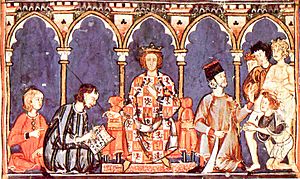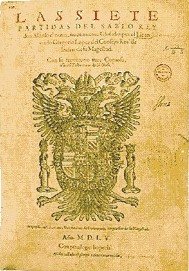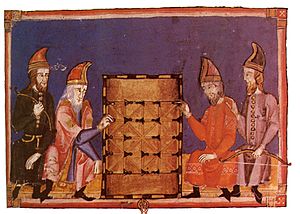Literature of Alfonso X facts for kids
Alfonso X of Castile, often called Alfonso the Wise, was a king who ruled from 1252 to 1284. He wanted to make his kingdom, Castile, a leading place for learning and art. His goal was to create a united, educated, and artistic society.
To do this, Alfonso encouraged a lot of cultural activities. This included creating and translating many books. These books were meant to help ordinary people in Spain learn new things. So, most of the works from his time were written in Castilian (which later became Spanish). This was different from Latin, which was the main language for important books back then.
Alfonso X didn't write most of these books himself. As a king, he had many other duties! Instead, he chose which books to create or translate. He also paid for the projects, picked the writers, and watched over the work. Sometimes, he even helped write parts of them.
Contents
Important Laws and Government Works
One of the most important works from Alfonso X's time was a set of laws. It was called the "Siete Partidas" (meaning "Seven Parts"). Even though it was finished in 1265, Alfonso thought it was too advanced for his time.
The legal code actually used during his rule was called the "Fuero Real". A team of Alfonso's legal experts created this one. Another important work ordered by Alfonso X was the "Setenario". This book focused only on religious topics.
The "Seven Parts" Law Book
The "Siete Partidas" was a legal code based on Roman law. A group of legal experts chosen by Alfonso X put it together. It was probably finished by 1265, but it didn't become law until 1348. That was during the rule of Alfonso XI, a later king. Alfonso X believed the code was too complex for Spain in the 1200s.
The author Robert Burns said that Alfonso thought the number seven was special. That's why he divided his legal code into seven main parts. Each part had many headings and subheadings. For example, the first part alone had 24 headings and about 500 smaller sections!
The seven parts covered these subjects:
- Part 1: The church and religious life
- Part 2: Public laws and government
- Part 3: How justice was managed
- Part 4: Marriage
- Part 5: Business and trade
- Part 6: Wills and what people inherited
- Part 7: Crimes and their punishments
The "Siete Partidas" was so advanced that it is still important today. It even helped create some of the laws used in the United States. Because of this, you can see an image of Alfonso X in the US House of Representatives!
Spain's History Books
Alfonso X didn't write the big history books published during his reign. But he did personally oversee their creation. The Estoria de España is a history of Spain itself. It starts from ancient times and goes almost up to Alfonso X's own era.
Work on this history was stopped because Alfonso became very excited about another history book. This second book was the General Estoria.
The "History of Spain"
This book tells the story of Spain from ancient times. It even includes very old details found in the Bible or other sources. It goes up to the rule of Fernando III of Castile, who was Alfonso X's father.
The book is split into four main parts:
- The first part covers the history of Ancient Rome.
- The second part tells about the barbarian and Gothic kings.
- The third part is about the Kingdom of Asturias. This is where the Reconquista began, which was the Christian effort to take back the Iberian Peninsula from Muslim rule.
- The fourth part covers the history of the Kingdoms of León and Castile.
The main sources for this work were two Latin chronicles. These were Chronicon mundi by Lucas de Tuy and De rebus Hispaniae by Rodrigo Ximénez de Rada. Other sources included the Bible, old Latin history books, church stories, epic poems, and writings from Arab historians.
The "General History"
The General Estoria was a history of the entire world. It started with Alfonso's ideas about how the world began, as told in the Bible. It ended close to the birth of Jesus Christ in the year zero.
This was not just a history of politics. The General Estoria also included the social and cultural history of the world. This work helped set the stage for how history would be written in Spain. It was the first book of its kind written in a common language, not in Latin. Alfonso wanted it to be accurate. So, many different sources were used, including classical, Christian, Arabic, and French texts. Alfonso hoped that publishing such an important book in Castilian would help people learn and appreciate more.
Amazing Science Books
Many science books from Alfonso X's time were translations of older Arabic works. But they were often updated with new information. A special group of Jews who spoke three languages translated these works into Castilian.
Four major science books made under Alfonso's guidance were:
- Tablas alfonsíes (Alfonsine Tables)
- Libros del saber de astronomía (Books of Wisdom of Astronomy)
- Libro de los juicios de las estrellas (Book of Judgments of Astrology)
- Lapidario
The Tablas alfonsíes were translated and updated from work by al-Zarqali.
These tables showed the movements of planets and stars. They were updated only after more than ten years of observations in Toledo. The Libros del saber de astronomía was an updated version of the astronomy work by Ptolemy. It included more than twelve different scientific writings. Alfonso was very interested in space. He even tried to find the perfect astrological clock, but he wasn't successful.
The Libro de los juicios de las estrellas was more about astrology, which is about how stars might affect people's lives. This book is interesting because it shows how the Spanish language changed over time. Words often had different spellings, and sometimes Catalan words were used. The Lapidario is also important for language studies. It talks about the medical uses of different rocks and gems and has amazing pictures. It often used words directly from Arabic because there weren't Castilian words for naming the stones yet.
Books About Religion
Alfonso X's rule was known for its religious tolerance. This means he allowed different religions to exist peacefully. His literature included translated works from Arabic cultures. It also had translations of non-Christian religious books.
The Qur’an, the holy book of Islam, was translated into Castilian because Alfonso ordered it. The Talmud, the holy book of Judaism, was also translated. So was Cabala, which is a mystical part of Judaism.
Other Interesting Books
Alfonso X wanted to improve the knowledge and tastes of ordinary Spanish people. One of the books he had translated was La escalera de Muhammad (Book of Muhammad's Ladder). This book had amazing descriptions of Heaven and Hell. These descriptions later influenced Dante when he wrote his famous poem, Inferno.
Besides serious intellectual works, Alfonso X also oversaw the creation of more everyday books. Calila e Dimna was a collection of stories originally from Asia. This book became very popular in Spain. It also influenced how fiction developed across Europe.
Alfonso also had Libro de ajedrez, dados, y tablas (The Book of Games) translated into Castilian from Arabic. He added illustrations to make the book even better.
See also
 In Spanish: Literatura de Alfonso X el Sabio para niños
In Spanish: Literatura de Alfonso X el Sabio para niños






